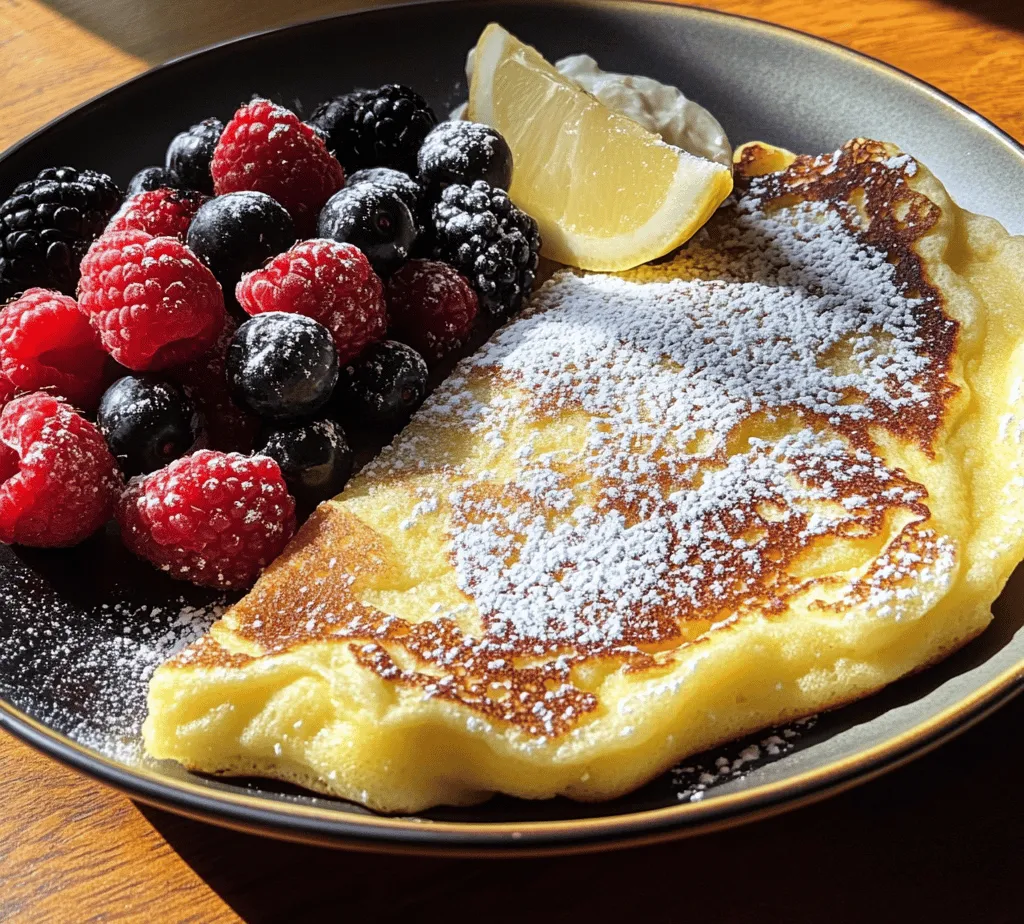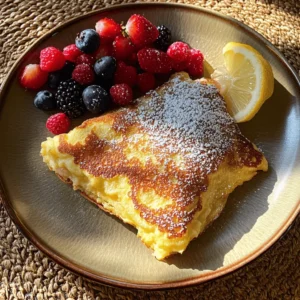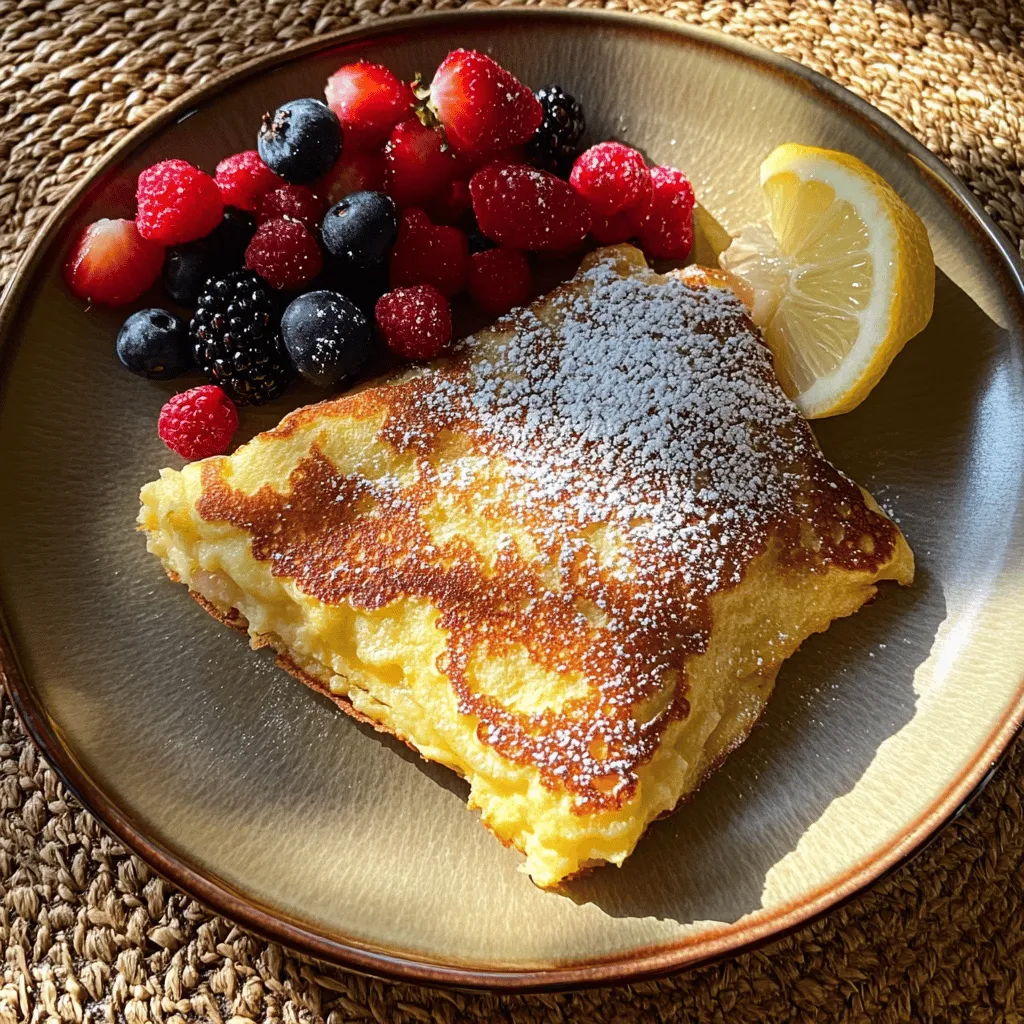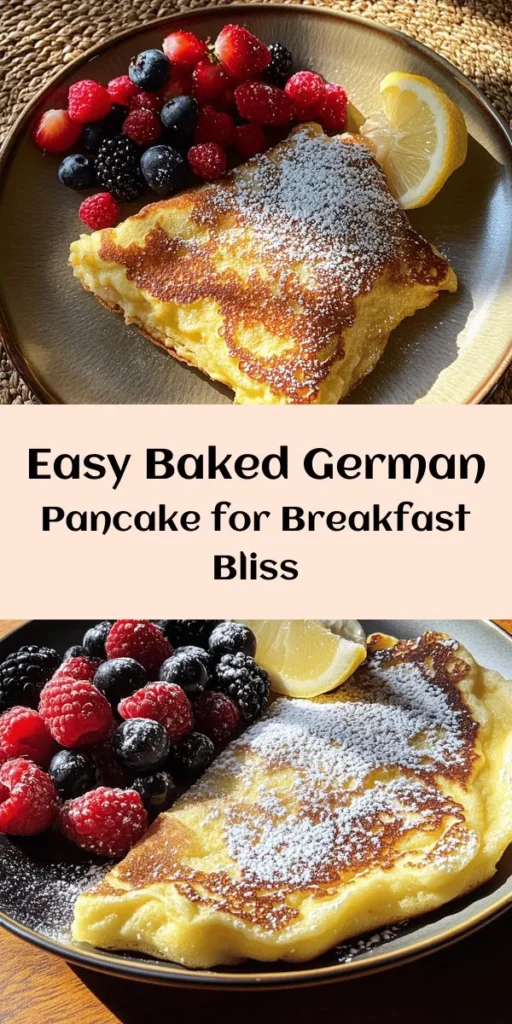Introduction
Pancakes have long held a special place in breakfast culture, gracing tables from cozy kitchens to bustling brunch spots around the world. These fluffy delights are not only a comforting start to the day but also a canvas for creativity, inviting an array of toppings and flavors. As breakfast enthusiasts seek new ways to elevate this beloved dish, the Baked German Pancake Delight emerges as a unique twist on traditional pancakes.
This delightful recipe transforms the familiar pancake experience into an oven-baked masterpiece that is sure to impress both family and guests alike. Unlike its skillet-cooked counterpart, the Baked German Pancake puffs up beautifully in the oven, creating a light and airy texture that is both satisfying and visually stunning. Perfect for busy mornings, this recipe requires minimal hands-on time, allowing you to enjoy a delicious breakfast without the fuss.
Understanding the Baked German Pancake
So, what exactly is a German pancake, and how does it differ from its regular pancake peers? Also known as a Dutch baby, the German pancake is characterized by its large, fluffy, and puffy appearance. While traditional pancakes are cooked on a griddle and served in individual portions, the German pancake is baked in a single dish, often a cast-iron skillet or a baking dish. This method allows the batter to rise dramatically while baking, resulting in a light, airy pancake that is crisp around the edges and soft in the center.
Historically, German pancakes have roots in culinary traditions that date back centuries. They were popularized in America by German immigrants, who brought their love for simple yet satisfying dishes. The Baked German Pancake Delight is a modern interpretation that retains the essence of this classic dish while adding a touch of flair that makes it perfect for special occasions or the everyday breakfast table.
When it comes to flavor and texture, the Baked German Pancake Delight excels. The combination of eggs and milk creates a rich, custard-like batter that puffs up during baking, resulting in a pancake that is both delicate and robust. With a hint of sweetness from the sugar and the warmth of vanilla, each bite of this pancake is a delightful experience that can be paired with various toppings, from fresh fruits to maple syrup.
Ingredients Breakdown
To achieve the perfect Baked German Pancake Delight, you will need a few key ingredients, each playing a vital role in creating the ideal texture and flavor. Let’s break down these ingredients:
– All-Purpose Flour: The backbone of the batter, all-purpose flour provides the necessary structure and texture to the pancake. It helps create a light yet sturdy base that holds up to the rising action in the oven.
– Milk: This crucial ingredient adds moisture and richness to the batter. The milk not only enhances the flavor but also contributes to the pancake’s soft and fluffy texture.
– Eggs: Eggs are the stars of this recipe, contributing to the pancake’s fluffiness and serving as a binding agent. When whipped and baked, they help the pancake rise and create a custard-like interior.
– Granulated Sugar: A touch of sweetness is essential to balance the flavors. Granulated sugar not only sweetens the pancake but also aids in caramelization during baking, giving the edges a beautiful golden brown color.
– Vanilla Extract: A splash of vanilla extract enhances the overall flavor profile of the pancake, adding depth and warmth that complements the sweetness.
– Salt: A pinch of salt is vital in any baking recipe, as it helps to balance the sweetness and enhance the flavors of the other ingredients.
– Unsalted Butter: Butter plays a dual role in this recipe. First, it adds rich flavor, and second, it helps in browning the pancake, giving it that deliciously crispy edge.
– Powdered Sugar and Fresh Toppings: While optional, a dusting of powdered sugar adds visual appeal and a touch of sweetness for serving. Fresh fruits, syrup, or even whipped cream can elevate the pancake, making it a delightful centerpiece for your breakfast table.
Preparation Steps
Now that we’ve covered the ingredients, let’s move on to the preparation steps for the Baked German Pancake Delight. Follow these simple instructions to create a fluffy breakfast that will impress everyone at your table:
1. Preheat the Oven: Start by preheating your oven to 425°F (220°C). This high temperature is crucial for achieving that signature puffiness that makes a German pancake so special.
2. Prepare Your Dish: While the oven is heating, select a large cast-iron skillet or a baking dish (approximately 9×13 inches). Add the unsalted butter to the dish, and place it in the oven to melt. Keep an eye on it to ensure it doesn’t brown too much—just enough to melt and coat the bottom.
3. Mix the Batter: In a mixing bowl, combine the all-purpose flour, granulated sugar, and salt. Whisk these dry ingredients together until well-blended. In a separate bowl, beat the eggs until frothy, then whisk in the milk and vanilla extract. Gradually add the wet mixture to the dry ingredients, stirring until just combined. Be careful not to overmix; a few lumps are perfectly fine.
4. Pour the Batter: Once the butter has melted and the oven is ready, remove the dish from the oven (using oven mitts, as it will be hot!). Carefully pour the batter into the hot buttered dish. The batter should sizzle slightly upon contact, which is a good sign.
5. Bake: Place the dish back into the oven and bake for 20-25 minutes, or until the pancake is puffed and golden brown. Avoid opening the oven door during baking, as this can cause the pancake to deflate.
By following these initial steps, you are well on your way to creating a beautiful Baked German Pancake Delight that will leave your breakfast guests in awe. Stay tuned for the next part, where we will delve into serving suggestions, tips for achieving the best results, and answers to common questions about this delightful dish.

Whisking the Batter: Tips for Achieving a Smooth Consistency
The first step towards creating a perfect Baked German Pancake Delight is ensuring that the batter is smooth and lump-free. Begin by gathering your ingredients, which will typically include eggs, milk, flour, and a pinch of salt.
1. Use Room Temperature Ingredients: For the best results, ensure that your eggs and milk are at room temperature. This helps in creating a homogenous batter that blends well, preventing any lumps from forming.
2. Whisking Technique: Start by cracking the eggs into a mixing bowl. Use a whisk or an electric mixer on a low setting to beat the eggs until they are frothy. Gradually add in the milk, continuing to whisk. Finally, sift in the flour and salt while whisking to incorporate the dry ingredients evenly. The key here is to whisk gently yet thoroughly until the batter resembles a smooth liquid without any lumps.
3. Avoid Overmixing: While a smooth batter is essential, overmixing can lead to a dense pancake. Mix just until combined. A few small lumps are acceptable and will not affect the final texture.
Melting the Butter: Importance of Using a Hot Dish
Once your batter is ready, it’s time to prepare the baking dish. The melting of butter is a crucial step that significantly impacts the pancake’s texture and flavor.
1. Preheat Your Oven: Before melting your butter, preheat your oven to 425°F (220°C). A hot oven is essential for achieving that distinctive puff.
2. Choose the Right Dish: A cast-iron skillet or a glass baking dish works best for this recipe. The choice of dish affects how the heat distributes and helps the pancake puff effectively.
3. Melting the Butter: Place your chosen baking dish in the preheated oven for a few minutes. Once heated, carefully remove the dish and immediately add the butter. The butter should melt quickly and begin to bubble, which not only adds flavor but also creates a non-stick surface for the batter.
Pouring and Baking: Ensuring Even Distribution for Perfect Puffing
With the butter melted, it’s time to pour in the batter. This step is vital for ensuring that your pancake puffs up evenly.
1. Pouring Technique: Carefully pour the batter into the center of the hot, buttered dish. The batter will spread out naturally, but to ensure even distribution, you can tilt the dish slightly in different directions. Avoid stirring at this stage; just let the batter settle.
2. Baking Time: Return the dish to the oven immediately to prevent the batter from cooling down. Bake for about 20-25 minutes, or until the pancake is puffed and golden brown around the edges. Do not open the oven door during the first 15 minutes of baking, as the sudden temperature drop may cause the pancake to deflate.
Cooling and Serving: How to Best Present the Dish
After baking, allow your pancake to cool for a few minutes before serving. This cooling period will help the pancake set slightly, making it easier to slice and serve.
1. Serving Style: You can cut the pancake directly in the baking dish or transfer it to a serving platter. For a charming presentation, consider dusting it with powdered sugar or a drizzle of maple syrup.
2. Garnishing: A sprinkle of fresh herbs like mint or a dusting of cocoa powder can add a delightful touch to the presentation.
Serving Suggestions
The Baked German Pancake Delight is versatile and can be enjoyed with a variety of toppings, making it a perfect dish for any breakfast or brunch occasion.
Ideas for Delicious Toppings and Pairings
1. Fresh Lemon Juice: A squeeze of fresh lemon juice over the warm pancake enhances its flavor profile. The acidity balances the sweetness and adds a refreshing zing that brings the dish to life.
2. Mixed Berries: Adding a medley of mixed berries—such as blueberries, raspberries, and strawberries—not only brings vibrant color but also a burst of natural sweetness. Berries are rich in antioxidants and vitamins, making them a healthful addition.
3. Alternative Toppings: Consider adding whipped cream, yogurt, or a scoop of ice cream for a decadent twist. For those who prefer a savory flavor, toppings like sautéed mushrooms or spinach can create a unique dish that strays from the traditional sweet pancake.
The Science Behind the Puff
Understanding the science behind why the Baked German Pancake puffs up can enhance your cooking skills and prevent common mishaps.
1. Heat and Air: The high heat in the oven causes the air trapped in the batter to expand. This rapid expansion is what creates the pancake’s characteristic puff.
2. Role of Eggs: Eggs are vital for the structure and stability of the pancake. They provide protein that helps set the structure as it bakes, while also contributing to the overall rise.
3. Troubleshooting Common Issues: If your pancake turns out flat, check the oven temperature with an oven thermometer. An oven that is not hot enough can lead to a pancake that doesn’t rise properly. Additionally, ensure that you are using fresh ingredients, as stale flour or old eggs can affect the batter’s ability to puff.
Nutritional Information
The Baked German Pancake Delight is not only delicious but also offers a balance of nutrients, making it a great breakfast option.
1. Overview of Nutritional Components: A serving of this pancake is typically rich in protein from the eggs, carbohydrates from the flour, and calcium from the milk.
2. Dietary Modifications: For those with dietary preferences, consider using gluten-free flour for a gluten-free version or almond milk for a dairy-free option. These substitutions can maintain the pancake’s texture while catering to specific dietary needs.
Cultural Variations and Adaptations
Pancakes are a beloved dish across many cultures, each with its own unique twist. Exploring these variations can inspire your own adaptations of the Baked German Pancake.
1. Regional Versions: In France, crêpes are thin and delicate, often filled with sweet or savory ingredients. In contrast, American pancakes are typically thicker and fluffier.
2. Adaptations: The Baked German Pancake can easily incorporate flavors from other cuisines. For instance, adding spices like cinnamon or nutmeg can give it a warm, cozy flavor reminiscent of fall. You could also experiment with fillings such as chocolate chips, nuts, or even savory ingredients like cheese and herbs.
Conclusion
The Baked German Pancake Delight is a unique and appealing addition to any breakfast table. Its fluffy texture and versatility make it a dish that can be customized to suit a variety of tastes and occasions. Whether you enjoy it with a sprinkle of lemon juice and berries or prefer a more decadent approach with whipped cream and chocolate, this pancake is sure to impress.
We encourage you to try this recipe and share the joy of this delightful dish with family and friends. Cooking is not just about nourishment; it’s about creating memories and enjoying the company of loved ones. The Baked German Pancake Delight offers a perfect opportunity to do just that, making every breakfast an occasion to remember.



